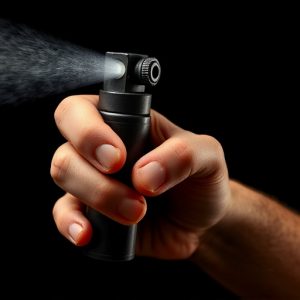Pepper Spray vs Taser: Understanding Effectiveness & Safety
Pepper spray and Tasers, both non-lethal self-defense tools, have distinct advantages. Pepper spray…….
Pepper spray and Tasers, both non-lethal self-defense tools, have distinct advantages. Pepper spray irritates sensory systems for quick incapacitation but offers less precision; Tasers use electrical current to override muscle resistance, more effective against larger assailants. Effectiveness varies based on user fitness, distance, weather, clothing, and tool type. For close encounters, pepper spray's broader range is ideal; Tasers excel in indoor settings or resistant attackers. Choosing between them depends on individual needs, training, and specific threats. Responsible use includes understanding legalities, storage safety (keeping out of children's reach), and adhering to manufacturer guidelines for optimal effectiveness and personal safety.
Personal safety is a top priority, and knowing how to protect yourself in various situations can make all the difference. This article delves into two powerful personal defense tools: pepper spray and tasers. Understanding their unique benefits and limitations is crucial when choosing the right self-defense mechanism. We explore how taser technology differs from traditional pepper spray and provide insights on effectiveness, safety considerations, and responsible use. By comparing these weapons, individuals can make informed decisions to enhance their personal safety, ensuring they are prepared for unexpected challenges.
- Understanding Pepper Spray: Benefits and Limitations
- Taser Technology: How Does it Differ from Pepper Spray?
- Comparative Effectiveness: When to Choose Each Weapon
- Safety Considerations: Responsible Use and Storage of Both Devices
Understanding Pepper Spray: Benefits and Limitations
Pepper spray, an aerosolized chemical compound, is a popular personal safety tool known for its ability to temporarily incapacitate an aggressor by causing intense irritation and pain in the eyes and respiratory system. When compared to Tasers, which use electrical current to disrupt muscle control, pepper spray offers unique advantages such as non-lethal nature, wide availability, and ease of use. It can be a game-changer in close-quarters confrontations, enabling users to create distance from potential threats.
However, pepper spray also has limitations. Its effectiveness depends on factors like the user’s fitness, mental state, and proximity to the aggressor. Additionally, weather conditions, clothing, and even the type of pepper spray can impact its performance. Unlike Tasers, which require direct contact or a certain distance for optimal effect, pepper spray is generally more versatile but less precise, leading to situations where it might not deter an attacker as intended. Understanding these nuances is crucial when considering personal safety equipment like pepper spray versus alternatives such as Tasers for self-defense purposes.
Taser Technology: How Does it Differ from Pepper Spray?
Taser technology and pepper spray are both non-lethal self-defense tools, but they function quite differently. Pepper spray temporarily incapacitates an attacker by irritating the eyes, nose, and respiratory system, making it difficult for them to see or breathe effectively. It’s known for its fast-acting properties, providing users with a crucial moment to escape or defend themselves. On the other hand, Taser technology uses electrical current to disrupt muscle control in an opponent, leading to temporary paralysis. This method is often considered more powerful and can stun an assailant for several minutes, giving users ample time to get away safely.
When comparing Pepper Spray Vs Taser Effectiveness, studies suggest that both have varying levels of success depending on the situation. Pepper spray is generally easier to deploy and has a broader range, making it suitable for close-quarters combat. Tasers, however, can be more effective against larger or stronger individuals as the electrical current can overcome muscle resistance. The choice between the two often depends on personal preference, training, and the potential threat at hand.
Comparative Effectiveness: When to Choose Each Weapon
When comparing pepper spray vs. a taser for personal safety, understanding their unique effectiveness is key to making an informed choice. Pepper spray, often in aerosol form, is designed to cause temporary blindness and pain by irritating the eyes, nose, and throat. It’s highly effective at creating distance between you and potential threats, allowing for a swift escape. On the other hand, a taser uses electrical current to disrupt muscle control, causing the target to fall to the ground momentarily. Tasers are particularly useful in close-quarter encounters as they can incapacitate an attacker without necessarily causing permanent harm.
The choice between them depends on your specific needs and circumstances. Pepper spray is generally more suitable for outdoor or low-light situations where visibility is crucial, ensuring you maintain enough distance to recover after spraying. Tasers, with their immediate impact, are better suited to indoor scenarios or when facing resistant attackers. Both offer valuable self-defense options, but understanding their strengths helps individuals select the most effective tool for their personal safety arsenal.
Safety Considerations: Responsible Use and Storage of Both Devices
When considering personal safety, individuals often turn to pepper spray or a Taser as self-defense tools. However, it’s crucial to understand that both have distinct effectiveness and safety considerations. Pepper spray temporarily disables by irritating the eyes, nose, and throat, while a Taser uses electric current to disrupt muscle control, rendering the target immobile. Responsible use involves adhering to local laws and understanding the range, wind conditions, and potential for cross-contamination with pepper spray.
Storage is another critical aspect of safety. Both should be kept out of reach of children and in secure locations. Pepper spray should be stored in a cool, dry place, away from direct sunlight or extreme temperatures. A Taser, on the other hand, requires regular maintenance and should be charged periodically to ensure optimal performance. Always follow manufacturer guidelines for charging, storage, and disposal to maintain the device’s effectiveness and safety.
In comparing pepper spray vs. Tasers in terms of effectiveness for personal safety, each tool offers unique advantages. Pepper spray remains a popular choice due to its low cost and ability to temporarily disable an attacker without causing permanent harm. Tasers, on the other hand, provide increased range and power, making them ideal for de-escalating situations from a distance. The choice between them depends on individual needs, preferences, and specific scenarios one might face. Regardless of selection, responsible use and proper storage are paramount to ensure safety and maximize the effectiveness of these personal defense devices.


